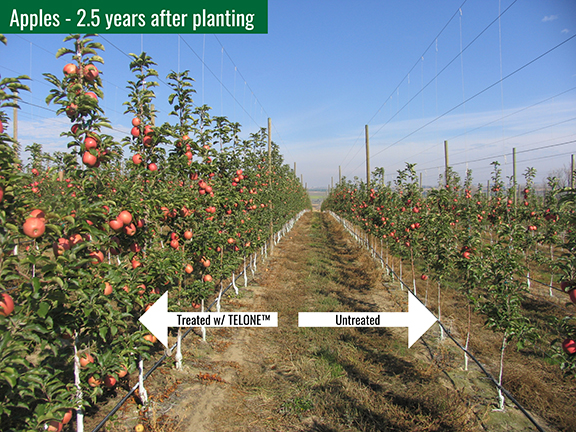Asiatic citrus canker, caused by Xanthomonas citri subsp. citri (Xcc) is a serious disease of most commercial citrus cultivars, but grapefruit is by far the most susceptible species. Grapefruit is the Florida citrus industry’s most important fresh fruit species with a value of $123 million in the 2009-2010 crop year. Compared with $174 million in 2005-2006, there has been a 30% decrease in crop value. This is due to legal restrictions preventing packing fruit exposed to canker, diversion of fruit to juice, restriction of shipping to export markets, abandonment of groves due to loss of profitability, and also decreased consumption. In October 2009, a new rule was published that discontinues APHIS inspections for canker on fresh fruit and opens up shipments to all U.S. states, even if symptoms of canker are present. However, about one-third of Florida’s exported citrus was sent to countries of the European Union (EU) during the 2007-2008 season and shipments to EU still require pre-harvest grove inspections as well as postharvest fruit inspection for canker before qualified for shipping.
Covering The Spread
Despite acceptance of canker-blemished fruit for U.S. shipment, the goal is still to reduce inoculum potential in fresh grapefruit groves as much as possible to ensure an economically viable pack-out is achieved. As predicted from studies in South America, windbreaks to reduce wind speed and inoculum spread, are essential to produce canker-free grapefruit under the typically rainy Florida conditions, especially on younger fruiting trees. Furthermore, grapefruit must be protected with copper sprays applied at 21-day intervals from spring flush until fruit reach full expansion. This interval between sprays is based on copper trials in Brazil with mid- and late-season oranges and is presumed to be applicable for grapefruit. Long-term use of copper bactericides has several disadvantages including induction of copper-resistance in Xcc populations and accumulation of copper in citrus soils with potential phytotoxic and adverse environmental effects. In trials conducted in Parana State, Brazil, from 2005 to 2007 streptomycin was the only alternative chemical that provided comparable disease control to copper in young orange trees.
A risk of season-long application of copper fungicides to grapefruit, especially after hot, dry periods, is phytotoxicity to the fruit rind. On grapefruit, blemishes make the fruit unacceptable for the fresh market. In Florida grapefruit, copper applied at 14- or 21-day intervals can cause considerable copper phytotoxicity to the fruit rind. Alternation of streptomycin (FireWall, Agrosource Inc.) with a reduced rate of copper provides similar disease control without copper phytotoxicity compared to the full rate of copper. Thus, reducing the copper rate lowers risk of copper phytotoxicity. In a 2007 trial, copper phytotoxicity in July was immediately preceded by rainfall after drought conditions from January to June. This led us to the hypothesis that rainfall after prolonged drought accelerates fruit growth and heightens the susceptibility of the rind to copper phytotoxicity. Hence, our field trials have been focused on evaluation of copper formulations, phytotoxicity, duration of residues, and the efficacy and timing of streptomycin for most effective control of canker on young, fruiting grapefruit trees.
In 2008-2010 field trials, copper formulations have been moderately effective for canker control with some performing slightly better than others. Magna-Bon, a chelated copper formulation, appears to perform as well as the standard copper formulations at a lower rate of metallic copper per application. Adjuvants or other additives with a reduced rate of copper do not improve the efficacy of copper. In our young fruiting tree trials, the best treatments reduce incidence of canker fruit to no lower than 10% to 20%, which might disqualify fruit for packing irrespective of the market destination. This is consistent with the requirement for windbreaks to sustain canker control on young grapefruit trees. In older grapefruit blocks with hedgerows, internal wind breaking appears to be sufficient, but tropical storms with sustained periods of windblown rain drive bacteria into stomates and cause wounds creating additional opportunity for infection.
Weather Factors
Without windbreaks, late season tropical storms may completely overcome the disease control attained with earlier season sprays. During Tropical Storm Fay in 2008, the protective film of copper, regardless of rate and formulation, was overcome by wind-driven rain containing bacterial inoculum. To potentially augment late-season control, streptomycin substituted for or applied with a reduced rate of copper provided somewhat greater control than copper alone. Disease control activity after Tropical Storm Fay is attributed to the ability of streptomycin to become locally systemic and reduce the development of post penetration infections.
In our evaluation of season long copper applications for three seasons, prolonged periods of drought in the spring to early summer followed by rainfall in July creates risk of copper phytotoxicity. This rainfall period stimulates a higher rate of fruit growth, which predisposes the rind to copper injury. Accelerated fruit expansion thins the cuticle on the fruit rind and provides more avenues for bacterial infection as new stomates are opening. Grapefruit are still susceptible to infection until the fruit reach full expansion. Hence, the recommendation is to protect fruit until fruit growth slows or stops.
Protecting rapidly expanding fruit surfaces with copper films that do not redistribute is very challenging without increasing the frequency of applications to an economically unsustainable level. Based on the evaluation of residual copper on grapefruit, time after spray application is the most important factor contributing to a significant reduction in copper residue per fruit surface area. Apparently the copper film cracks and exposes unprotected areas on the surface as the fruit expands. Different copper formulations tested so far behave similarly, hence no one copper formulation is superior to the others for protection of the fruit.
New California Citrus Breeding Program on the Grow With Funding
Graham works at the UF/IFAS Citrus Research and Education Center in Lake Alfred.
See all author stories here.









